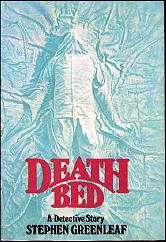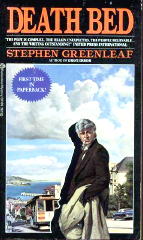Mon 5 Jul 2010
A 1001 MIDNIGHTS review: STEPHEN GREENLEAF – Death Bed.
Posted by Steve under 1001 Midnights , Reviews[3] Comments
by Marcia Muller:

STEPHEN GREENLEAF – Death Bed. Dial Press, hardcover, October 1980. Paperback reprints: Ballantine, May 1982; Bantam, December 1991.
Stephen Greenleaf has received a great deal of critical acclaim for his novels featuring John Marshall Tanner, former lawyer turned private eye.
Tanner’s territory is the San Francisco Bay Area, where his cases take him into the homes of the rich and powerful, as well as into the lowest dives in the city; the author draws heavily on his knowledge of politics, business, and local events to flesh out Tanner’s investigations.
Greenleaf has been hailed as the successor to the Raymond Chandler/Ross Macdonald tradition, and it is easy to see why. Like Philip Marlowe and Lew Archer, Tanner is less a fully developed character than an observer. Hints are thrown out about his past and private life, but they are not elaborated upon, and frankly the reader doesn’t care.
Greenleaf makes extensive use of simile, as Macdonald did, but with far less success; often he seems to be stretching a point, reaching for a likeness that simply doesn’t come off. He is a successor to the tradition of the hard-boiled private eye developed by these writers in the sense that he is an imitator, and his work makes one wonder why we need further imitations.

Death Bed begins with a scene reminiscent of Philip Marlowe’s meeting with Colonel Stem wood in The Big Sleep. Maximilian Kottle, dying millionaire, wishes to hire Tanner to find his estranged son, Karl.
Kottle waxes philosophical about life and death — perhaps too much so for a man in such pain and close to death — and Tanner agrees to find his son for him. Karl’s mother, flamboyant romance novelist Shelley Withers, can give few clues to her son’s whereabouts, but through solid detective work — one of the strong points of this series — Tanner traces Karl, and is getting close when Belinda Kottle, beautiful young wife of Maximilian, calls to say Karl has contacted his father and is coming to see him.
Shortly afterward, Maximilian dies, and Tanner considers the case closed. He is then free to undertake a search for missing investigative reporter Mark Covington, but soon discovers the Kottle case is not only still open, but also linked to the journalist’s disappearance.
There are a few surprising twists here, but the case builds to a rather predictable conclusion, and the primary villain (there are many, of various sorts) is introduced so late in the narrative that the solution comes a little out of left field. Chandler and Macdonald simply did it better.
Other novels featuring John Marshall Tanner are Grave Error (1979), State’s Evidence (1982), and Fatal Obsession (1983).
———
Reprinted with permission from 1001 Midnights, edited by Bill Pronzini & Marcia Muller and published by The Battered Silicon Dispatch Box, 2007. Copyright © 1986, 2007 by the Pronzini-Muller Family Trust.
July 5th, 2010 at 1:48 am
This review by Marcia Muller is more sharply critical of Greenleaf’s approach to PI fiction, even more so than Barry Gardner in the review before this one. Barry largely expressed disappointment with SOUTHERN CROSS, the one he read, which came along later in the series, while DEATH BED was the second.
Since Greenleaf’s commercial success gradually faded, eventually to the point where he left mystery writing altogether, I think pointing out where he failed as well as where he succeeded is a worthwhile endeavor.
As a fan of Greenleaf’s detective fiction myself, I have to admit that Marcia may have put her finger on some of the former.
July 5th, 2010 at 2:10 am
Much as I liked Greenleaf, I think this hits the problems he had on the head. I do think Tanner became more of a character as the series progressed and Greenleaf got better with the use of metaphor and simile, but he never quite captured the voice and he certainly never mastered Macdonald’s plots.
Between these two reviews I think there is a fair look at why I read the books, and also why they eventually fell off my list and the series ended. But I did appreciate Greenleaf’s attempts to do something more within the genre, even if he never quite succeeded.
July 5th, 2010 at 5:14 am
It’s also a fair look at why I don’t read the books. There are just too many authors I prefer, though back in the day I at least tried as many private eyes as I could find.